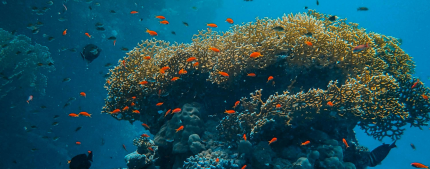Building Arks With NOAA

Last month, I had the chance to do something I’ve long wanted to do: see a coral reef before they are lost to bleaching. Over the last 30 years, nearly half of all the world’s coral reefs have been lost. It’s estimated that if trends continue, over 99% of tropical corals could be eradicated by the time I turn 80.
In the midst of this sobering reality, I swam among the coral—diseased and thriving. Bleached-white and brilliantly colored. I dove down into the warm waters of Bonaire, letting the current move me past coral heads where parrotfish crunched algae off the reef, and angelfish glided like stained-glass windows come to life. I hovered above elkhorn coral, their branches forming intricate buttresses beneath the sea, places of refuge for tiny fish darting in and out of their spires. I looked for cleaner shrimp, who were busy tending to their work, removing parasites from their larger hosts in an ancient ritual of mutual care. And I kept thinking: this doesn’t just happen.
With all the pressures of climate change, overfishing, and pollution, ecosystems aren’t naturally preserved, and certainly not protected by the market. The coral reefs of Bonaire were not there by accident. They were there because in 1979, the waters and the creatures that call it home were designated a Marine Protected Area. They survived because people chose to safeguard them. Because people built an ark.
We must build structures of resilience that can withstand the storms ahead. The ark, in this sense, is not an escape pod for a select few, but a commitment to preserving life and justice in the midst of crisis.
Timothy Gorringe, in his essay “On Building an Ark: The Global Emergency and the Limits of Moral Exhortation,” argues that the multitude of challenges facing humanity—climate collapse, biodiversity loss, economic instability—constitutes a global emergency. And an emergency, he writes, cannot be addressed merely by moral exhortation. It requires the construction of arks. He contrasts two biblical models: Jonah, who exhorted Nineveh to repent, and Noah, who was called to build an ark to preserve life through the deluge. Gorringe suggests that while moral warnings are necessary, they are not enough—like Noah, we must build structures of resilience that can withstand the storms ahead. The ark, in this sense, is not an escape pod for a select few, but a commitment to preserving life and justice in the midst of crisis.
An ark is not just a metaphor for survival; it is a blueprint for resilience. It is a tangible act of preparation, a sanctuary created against the flood. In Bonaire, the marine protected waters are an ark. And here in the United States, the National Oceanic and Atmospheric Administration (NOAA) is one of the greatest ark-builders we have.
NOAA doesn’t just study the ocean—it stewards it. It is the agency responsible for approving and safeguarding Marine Protected Areas in U.S. waters, ensuring that reefs, estuaries, and marine ecosystems have a fighting chance against the onslaught of climate change and extractivism. NOAA monitors hurricanes and rising sea levels, tracks fish populations and coral bleaching events, and provides the science necessary to guide policy decisions that affect our oceans and coasts. It operates the National Weather Service, providing life-saving forecasts and warnings for extreme weather events such as hurricanes, tornadoes, and floods. NOAA manages vital fisheries to ensure the sustainability of seafood stocks, preventing overfishing and maintaining the livelihoods of coastal communities. It tracks atmospheric and oceanic changes, studying the impacts of greenhouse gases and providing critical data for climate modeling. NOAA is, in the truest sense, an ark-builder, constructing places of refuge in the midst of rising tides, while also equipping society with the knowledge needed to navigate the storm.
In Christian tradition, sanctuaries are places where God’s presence is encountered, where the sacred is preserved and tended with care.
And yet, even as the storms intensify, even as the waters warm and the reefs fade, the very agency tasked with protecting them is being gutted. The week I returned from Bonaire, hundreds of NOAA staff, including many in the Office of National Marine Sanctuaries, were fired. The people who dedicate their lives to safeguarding the sanctuaries of the sea were told their work was expendable. This is not just an administrative decision. It is a decision about what we value, about whether we will choose refuge or neglect.
In Christian tradition, sanctuaries are places where God’s presence is encountered, where the sacred is preserved and tended with care. The NOAA staff who oversee our marine sanctuaries are their stewards and caretakers—their ministers. To lose them is to fire the rectors at some of our most sacred cathedrals, leaving them untended precisely when they need the most care.
In Bonaire, I saw two possible futures: one where we build arks, protecting and restoring what remains, and one where we let the floodwaters take what they will. The choice is before us.
NOAA is one of our best tools for building arks in an age of deluge. We must protect it. We must fight for its funding, its staffing, and its mission. Because the waters are rising. And the work of building arks has never been more urgent.
Photo by Francesco Ungaro



